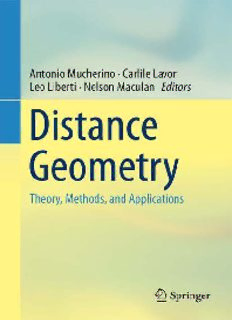
Distance Geometry: Theory, Methods, and Applications PDF
Preview Distance Geometry: Theory, Methods, and Applications
Distance Geometry Antonio Mucherino • Carlile Lavor Leo Liberti (cid:129) Nelson Maculan Editors Distance Geometry Theory, Methods, and Applications 123 Editors AntonioMucherino CarlileLavor IRISA,UniversityofRennes1, DepartmentofAppliedMaths Rennes,France UniversityofCampinas Campinas-SP,Brazil LeoLiberti Laboratoired’Informatique NelsonMaculan EcolePolytechnique AlbertoLuizCoimbraInstitute Palaiseau,France FederalUniversityofRiodeJaneiro RiodeJaneiro,Brazil ISBN978-1-4614-5127-3 ISBN978-1-4614-5128-0(eBook) DOI10.1007/978-1-4614-5128-0 SpringerNewYorkHeidelbergDordrechtLondon LibraryofCongressControlNumber:2012952099 ©SpringerScience+BusinessMediaNewYork2013 Thisworkissubjecttocopyright.AllrightsarereservedbythePublisher,whetherthewholeorpartof thematerialisconcerned,specificallytherightsoftranslation,reprinting,reuseofillustrations,recitation, broadcasting,reproductiononmicrofilmsorinanyotherphysicalway,andtransmissionorinformation storageandretrieval,electronicadaptation,computersoftware,orbysimilarordissimilarmethodology nowknownorhereafterdeveloped.Exemptedfromthislegalreservationarebriefexcerptsinconnection with reviews or scholarly analysis or material supplied specifically for the purpose of being entered and executed on a computer system, for exclusive use by the purchaser of the work. Duplication of this publication or parts thereof is permitted only under the provisions of the Copyright Law of the Publisher’slocation,initscurrentversion,andpermissionforusemustalwaysbeobtainedfromSpringer. PermissionsforusemaybeobtainedthroughRightsLinkattheCopyrightClearanceCenter.Violations areliabletoprosecutionundertherespectiveCopyrightLaw. Theuseofgeneraldescriptivenames,registerednames,trademarks,servicemarks,etc.inthispublication doesnotimply,evenintheabsenceofaspecificstatement,thatsuchnamesareexemptfromtherelevant protectivelawsandregulationsandthereforefreeforgeneraluse. While the advice and information in this book are believed to be true and accurate at the date of publication,neithertheauthorsnortheeditorsnorthepublishercanacceptanylegalresponsibilityfor anyerrorsoromissionsthatmaybemade.Thepublishermakesnowarranty,expressorimplied,with respecttothematerialcontainedherein. Printedonacid-freepaper SpringerispartofSpringerScience+BusinessMedia(www.springer.com) To ourparents Preface Theideaforthisbookwas bornduringtheToulouseglobaloptimization(TOGO) workshopin 2010,one in a series of globaloptimizationworkshops(GOWs) that are held all around the world every two or three years. We mentioned the idea to PanosPardalos,thedirectoroftheSpringeroptimizationanditsapplicationsbook series,whofounditgoodandtoldustogetintouchwiththepublisher. Distance geometry(DG) sets the conceptof distanceon the basis of Euclidean geometry.ThefundamentalproblemofDGisaninverseproblem,i.e.findingasetof pointsinspacewhosepairwisedistancesareequaltosomegivendistances.Among the most important applications we find molecular conformations, localization of sensornetworks,andstatics. Moleculesconsistofatoms;some pairwisedistances areknowneitherbecauseofchemicalreasonsorbecauseofnuclearmagneticreso- nance(NMR)experiments.Theproblemisthentocompute3Dmolecularstructures using distance information. In mobile sensor networks, pairwise distances can be measuredbecause the powerrequiredto establish a point-to-pointcommunication is proportionalto the distance: the problem faced by the network administrator is to locate all sensors in space. In statics, the interest is to construct bar-and-joint frameworksthat serve a given architecturalpurpose whilst being rigid, i.e. whose staticequilibriumishardtobreak.Otherapplications,notablytodatavisualization, robotic arms, unmanned underwater vehicles, clock synchronization, and music, alsoexist. Ourfirstmotivationforeditingthisbookisthatwearenotawareoftheexistence of an edited book on the subject of DG. Some come close, such as, e.g., [6] or [19], but neither focuses principally on DG. The papers in [6] are mostly about protein folding using partial information related to interatomic distances: this is certainlyoneofthemainapplicativedriversbehindDG,butthetheoreticalaspects areneglected.Thebook[19]comesclosertothetarget,sinceitisaverynicemix oftheoreticalandapplicationpapers;yetits maintopicis rigidityratherthanDG. Rigidgraphsaresometimesusedasmodelsforproteinsorsensornetworks,butit isoftenthecasethatnotenoughdistancesareknowntomakethegraphrigid. ThesecondmotivationstemsfromthefactthattheDGcommunityisbrokeninto segmentswhichreflectthemotivatingapplications(molecularconformation,sensor vii viii Preface networks,statics,andothers)aswellasthediscipline(mathematics,computersci- ence,biochemistry,engineering).Thereisneitherjournalnoraregularconference or workshop that is wholly dedicated to DG. This state of affairs is strange for a discipline that was born in the late 1920s and still produces a lot of valuable results.We thereforewantedtogentlyhelpthe researchersworkingin thisareato acquire a stronger communityidentity. As far as this motivationis concerned,we obtained a partial success: our call for papers was answered positively by around half of the people we had initially asked. On the one hand, this is to be expected ineditedbooks:someearlyauthorschangedsubjectsorretired,whilstsomeofthe activeoneshaveadministrativedutiesorsimplycannotaffordthetime.Ontheother hand,thisbookshowsthebiasofitseditors:mostapplicationpapersaredevotedto molecular conformation,which is what initially motivatedus, as authors,to work in DG. Althoughwe did send invitationsto researchersin the sensor networkand staticscommunities,fewknewofus,sofewofthemanswered. A third motivation is that we are planning to organize a workshop on DG in June2013inManaus,Brazil,which,wehope,willfurtherhelpshapingtheexisting magmaintoatrueDGcommunity.Althoughtheusualprocessderiveseditedbooks fromconferenceproceedings,wedecidedtousethisbookasabasistoformakernel ofresearcherswhomightbeinterestedinattendingtheworkshop. Distance geometrywas born in 1928,when Karl Menger characterized several geometricalconcepts,suchascongruenceandconvexity,bymeansoftheprimary notionofdistance.Thisattemptwasfarfromuncommonin the50yearscovering the turn of the century: several geometers asked themselves what would happen if some of the Euclidean axioms which had always formed the basis of geometry wereremoved.Hyperbolic,spherical,projective,andothertypesofgeometrieswere studiedandappliedtoengineeringproblems.WhenHilbertpushedmathematicians around the world to pay attention to the precision of their proofs, the community underwenta profoundchangeinvolvingthe axiomatizationof everymathematical discipline,includinggeometry.Thiseventuallystimulatedlogicandsettheoryand the remarkable works of Go¨del, Tarski, Post, and Turing. Alternative axiomatiza- tions of Euclidean geometry were sought in order to establish which geometrical conceptsweretrulyfundamentalandwhichwerenot.Theaxiomatizationworkon geometry,togetherwith thestudy ofGrassmann–Cayleyalgebras,gaverise to the use ofseveraldifferenttypesof distancecoordinateswhichwere thengeneralized intheframeworkofsolvingdistanceconstraintsystems,e.g.in[21]. Menger’s work was eventually continued by Blumenthal: the main question in DG, atthetime, wasto findnecessaryandsufficientconditionstodecidewhether agivenmatrixwasadistancematrix,i.e.asymmetricn×nmatrixD=(d )such ij thatthereexistsanintegerK >0 anda setofn points{x ,...,x } inRK withthe 1 n propertythat ∀u<v (cid:3)x −x (cid:3)=d , (1) u v uv Preface ix wherethenorm(cid:3)·(cid:3)isusuallytakentobeEuclidean(infact,allchaptersinthisbook makethisassumptionasidefrom[7],whichstraysfromthepathandconsiderswalk distances,insteadofedgedistances). A quarter century later, Yemini defined the positioning problem in sensor networks as: locate a set of geographically distributed objects using [...] the distancesbetweensomeobjectpairs.Themaindifferencewiththeearlierproblem is the word “some”: not all distances are given. Equivalently, some of the entries fromthematrixDaremissing.Accordingly,wedefinethefundamentalproblemin DG(intermsofgraphsinsteadofmatrices)asfollows. DISTANCEGEOMETRYPROBLEM(DGP).GivenanintegerK>0andasimpleweighted undirectedgraphG=(V,E,d),whered:E→Q+,decidewhetherthereexist|V|=npoints {x ,...,x }inRK with 1 n ∀{u,v}∈E (cid:3)x −x (cid:3)=d . (2) u v uv WeremarkthatintheDGP,Kisgivenaspartoftheinput.SometimesKneedstobe decidedaspartoftheoutput:forexample,findtheminimumKsuchthatasolutionx toEq.(2)exists.ThisisknownastheEuclideandistancematrixcompletionproblem (EDMCP).Thisseeminglyminordifferencehasanoticeableimpactontheproblem complexity:whereastheDGPisknowntobeNP-hard,thecomplexitystatusofthe EDMCPiscurrentlyunknown.WhethertheDGPitselfisinNPornotremainsan openquestion,exploredin[5]. ThenumberofsolutionsofEq.(2)canbeeitheruncountableorfinite,butnever countablyinfinitebecauseofsomewell-knownpropertiesofsemi-algebraicsets. In the first case, finding the certificates (i.e. the feasible realizations x = (x ,...,x )∈RKn ofG)usuallyrequirescontinuousormixed-continuousmethods. 1 n Mostofthesereformulate(2)intoaminimizationofsquaredpenaltyterms: min ∑ ((cid:3)x −x (cid:3)2−d2 )2. (3) u v uv x∈RKn{u,v}∈E In this reformulation, a solution x of the minimization problem is a solution of thecorrespondingDGPifandonlyif theoptimalobjectivefunctionvalueiszero. Amongthechaptersinthisbookthatdealwiththiscase,LocatelliandSchoen[14] proposes a population-based metaheuristic, Lima and Mart´ınez [13] uses a local nonlinearprogramming(NLP) solution algorithm,and An andTao [4] transforms (3)intoadifferenceofconvex(DC)functionsandsolvesitusingaDCprogramming method.The paper[1] proposesa heuristic method (SPE) which is directly based on the originalformulation(2). SPE’s simplicity is its strong point:it is specially suitedtomassivedatasetsandcanbeeasilyparallelized. Inthesecondcase,thegraphGissaidtoberigid.Rigiditytheoryisabeautiful andwell-developedmathematicaltheory,whosemainmotivatingapplicationisstat- ics.Averynicemathematicaloverviewofsomeimportanttheoreticalachievements in rigidity theory is given in [2]. In sensor networks the focus is on uniquely localizable graphs (i.e. graphs with sufficiently many edges so that Eq. (2) has a
Description: